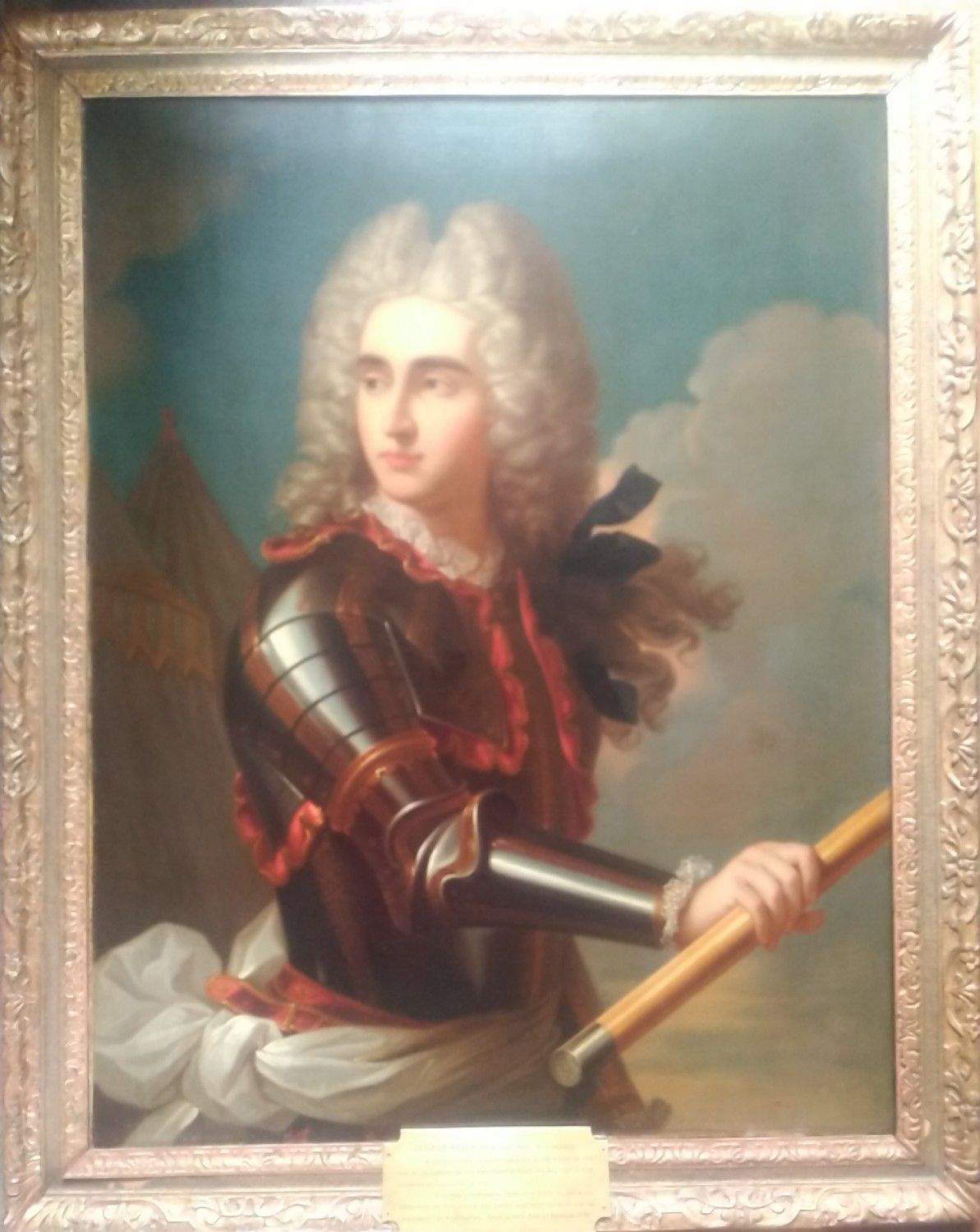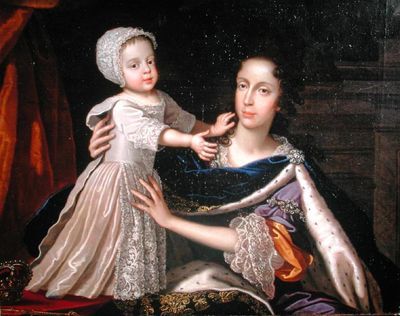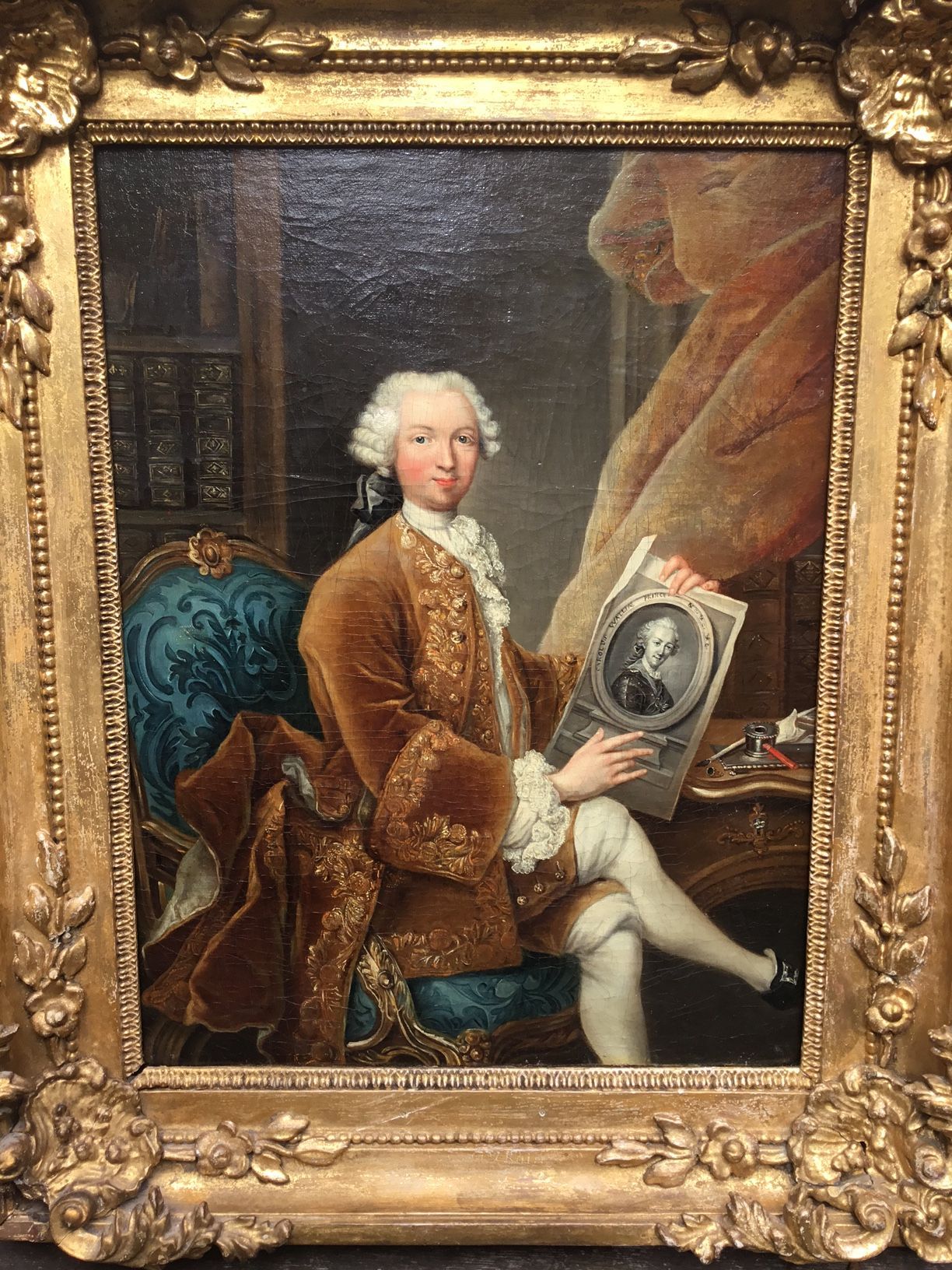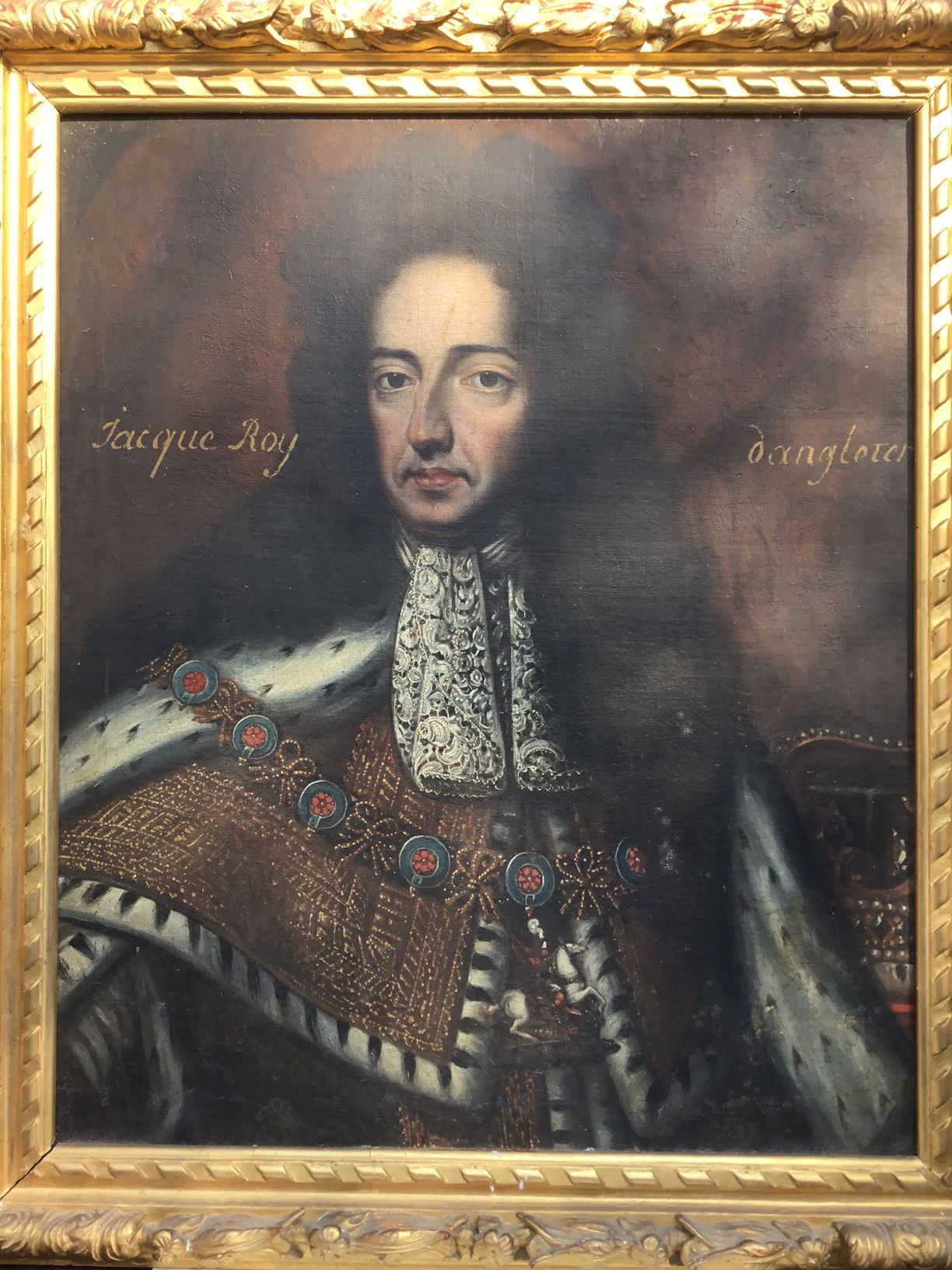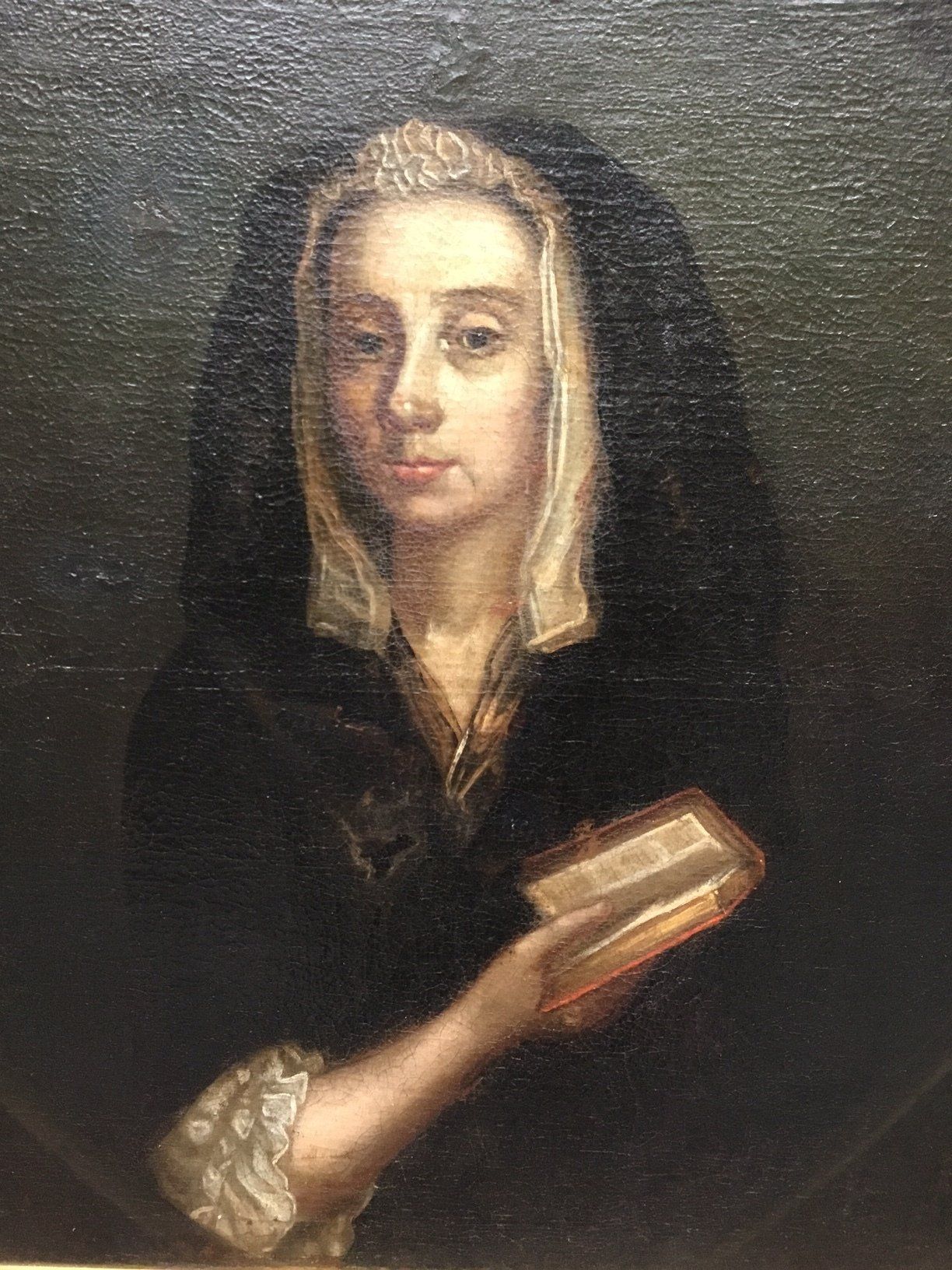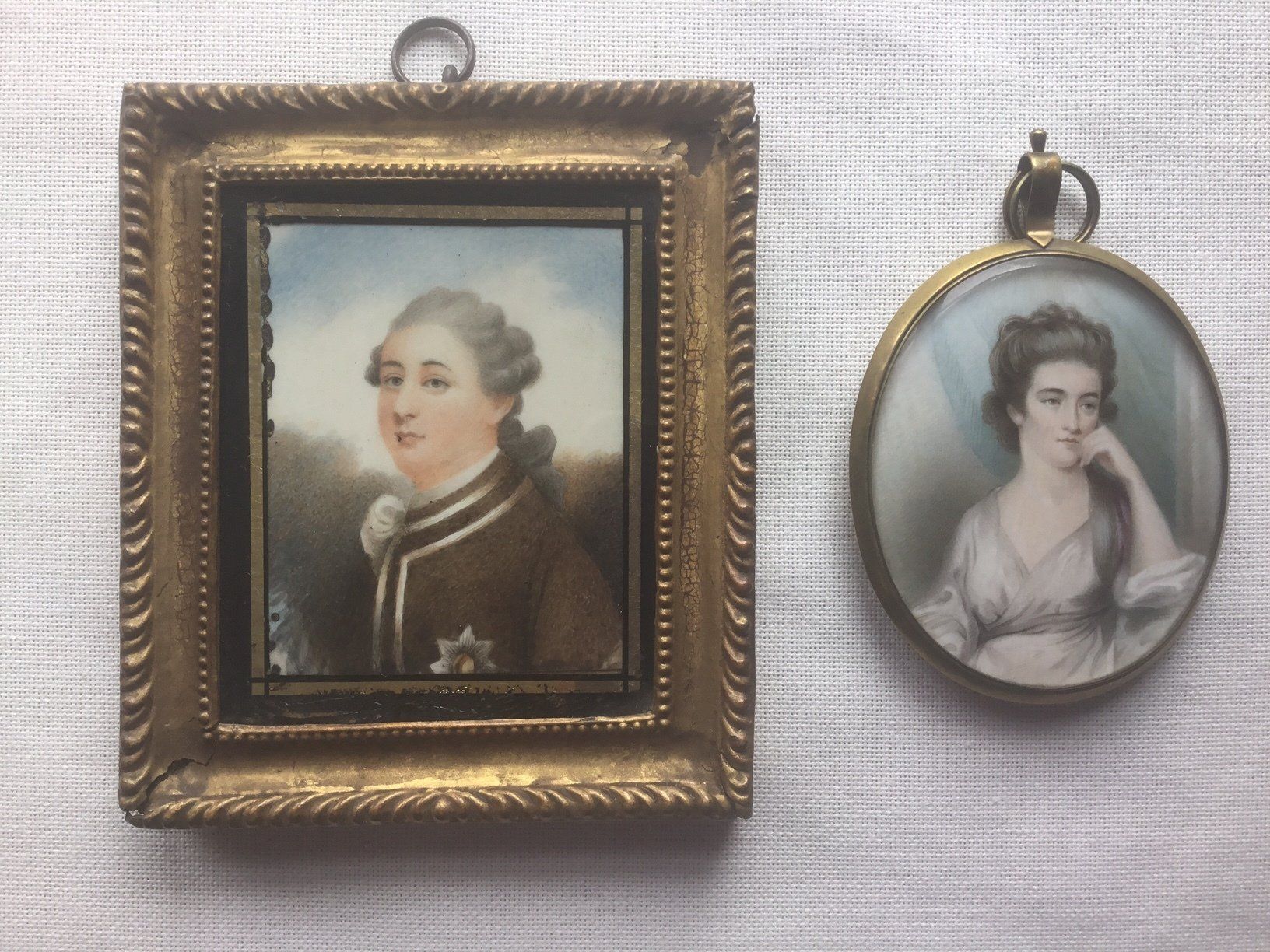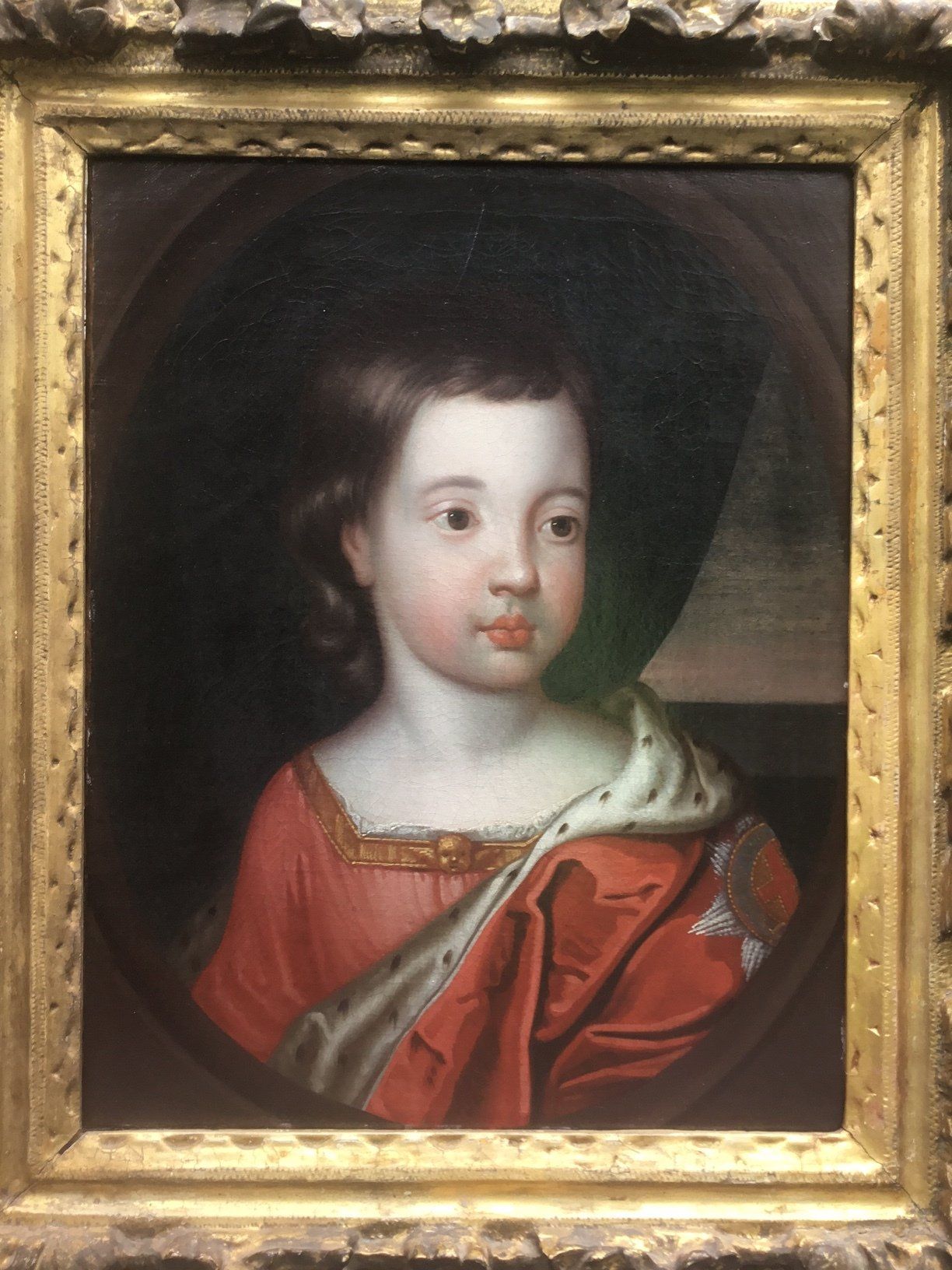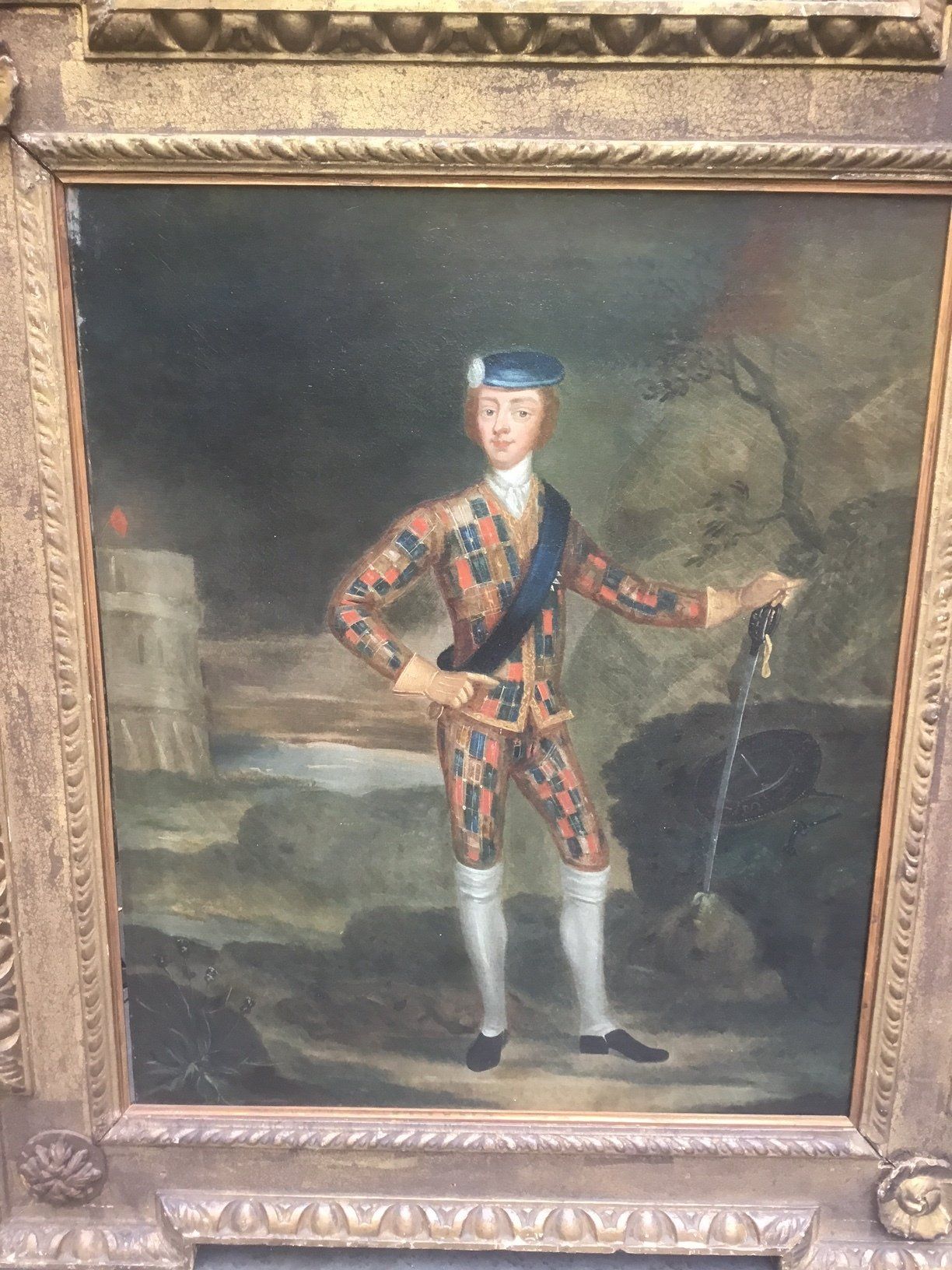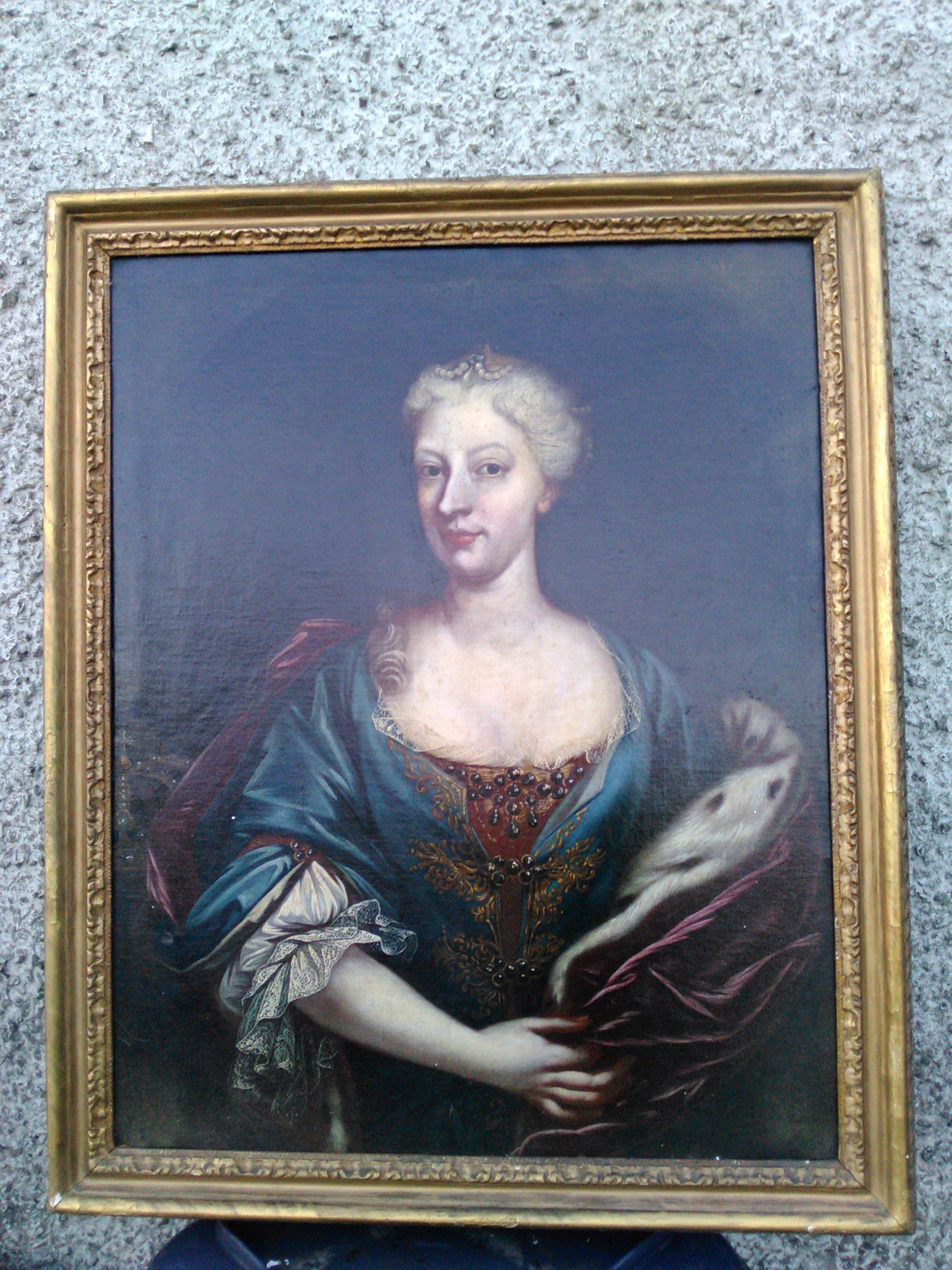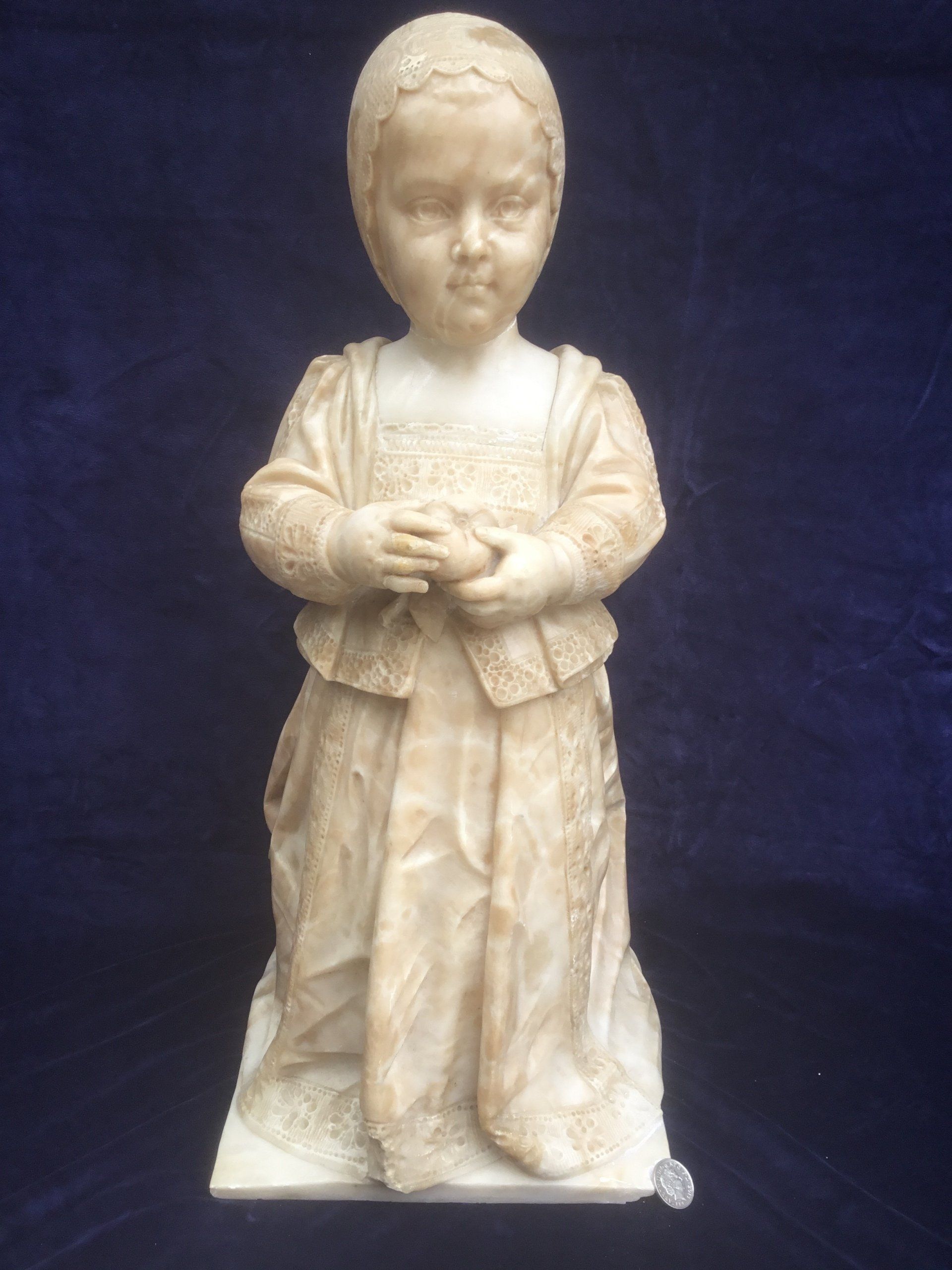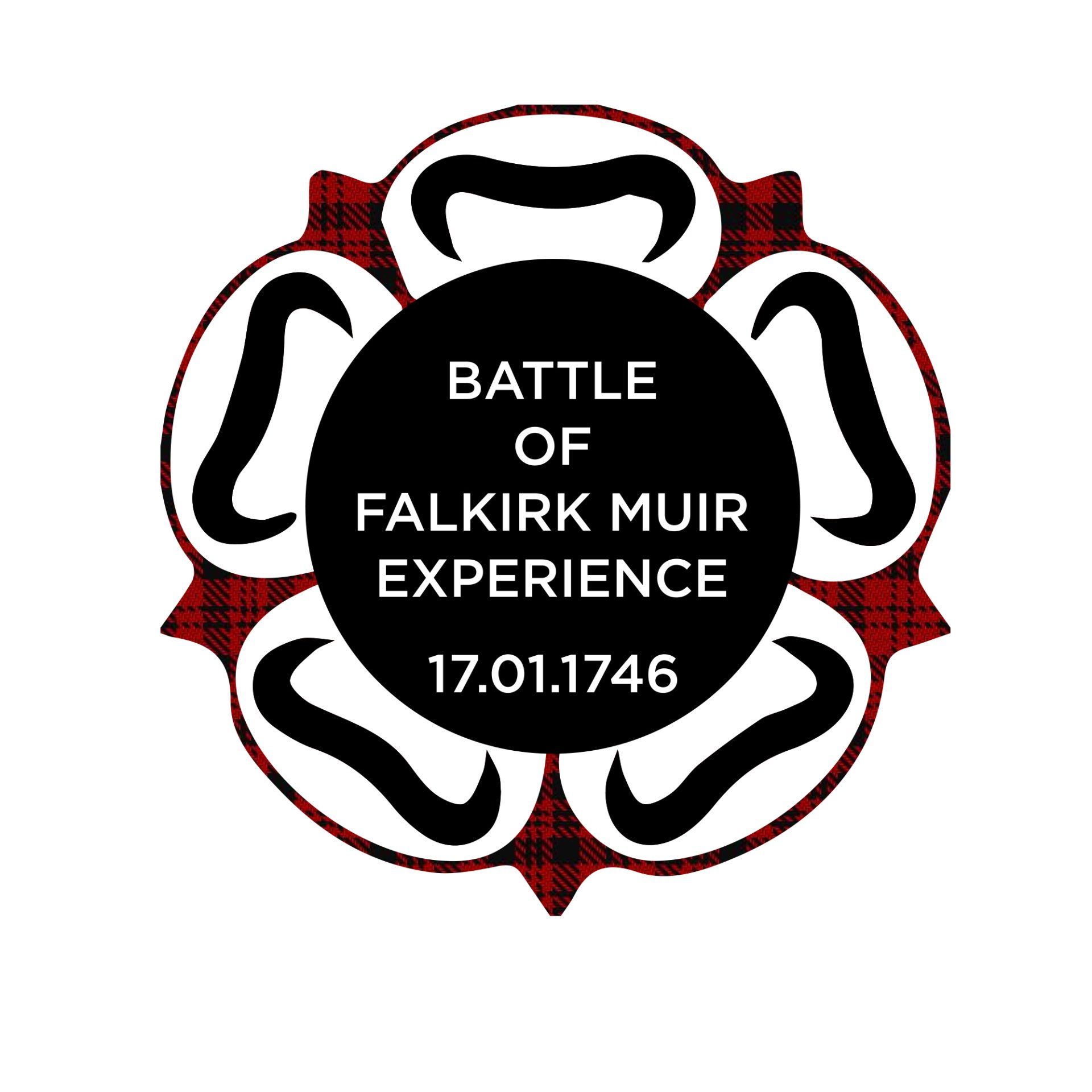Rooms 1 - Art Gallery
George Leith, 10th Earl Marischal
George Leith, 10th Earl Marischal
George Keith (Inverugie Castle, Aberdeenshire 1693-1778 Potsdam)
Pierre Parrocel (Avignon 1664-1739 Paris), oil on canvas.
George Keith must be ranked as one of the Stuart's most loyal subjects. He was the 10th and last Earl Marischal.
George fought at the battle of Sheriffmuir in 1715 and led the landing of Spanish troops near Eilean Donan Castle to kick start the Rising of 1719. The Jacobite force lost the subsequent battle at Glen Shiel.
During the 1740s he became disillusioned with Prince Charles' leadership and, in 1751, he went on to command Frederick the Great of Prussia's forces.
Added 21 June 2025
Prince Charles Edward Stuart
Prince Charles Edward Stuart
Charles Edward Stuart - The Young Pretender - Bonnie Prince Charlie (Rome 1720-1788 Rome).
Oil on canvas, artist unkown but possibly by the Scottish artist Cosmo Alexander (1724-1772).
This portrait is is a copy of a painting by the French artist Maurice Quentin de La Tour (1704-1788) which was painted a couple of years after Prince Charles returned to France following the collapse of the '45 Rising.
La Tour's painting was copied by the Scottish pastelist Catherine Reid (Dundee 1722-1778 Madras) while she lived in France. Shortly after the Treaty of Aix-la-Chapelle of 1748 Prince Charles was forced out of France when he went to live in Italy. In the years following the treaty many of the Jacobites also left France and followed Prince Charles to Italy.
It is possible that Reid would have met up with fellow Scot and artist Cosmo Alexander who was also living in Italy. This would have given Cosmo the opportunity to copy her version of La Tour's original.
Added 02 April 2025
News of Prestonpans
THE NEWS OF PRESTONPANS TO THE JACOBITES IN LONDON AT THE SMYRNA COFFEE-HOUSE
GEORGE OGILVY REID RSA ARSA (19 September 1851 Leith - Edinburgh 11 April 1928)
G Ogilvy Reid was a well respected Edinburgh artist who spent most of his life in and around Leith.
This large oil on canvas painting was first exhibited by the artist in the Royal Scottish Academy, Edinburgh in 1894, painting number 65.
The scene is meant to depict the reaction of the members of a London drinking club upon hearing the news from the man entering the room that the Jacobite forces under the command of Lord George Murray had won a decisive victory over the British army commanded by General Johnny Cope.
It is left to the viewer to decide if they men in the painting look happy at the news which would indicate we are looking at the members of a Jacobite drinking club. Alternatively do the men in the painting look concerned which would indicate they were members of a Hanoverian drinking club.
It was remarked that if the Jacobite supporting nobles fought as much as they drank Prince Charles would have been sitting on the throne in London.
Given the date that the painting was first exhibited perhaps the artist chose the subject to coincide with the 150th anniversary of the Battle of Prestonpans which was fought on 21st September 1745.
Since acquiring the painting we have done some research into the previous owners of the painting and have come across the following details:
The painting was either sold during the exhibition or soon afterwards to James Pringle who was an Edinburgh businessman living at 9 Rothesay Terrace, Edinburgh. He was a part owner of one of the largest Brewing Companies in the city.
Pringle subsequently loaned it to the 1901 Glasgow International Exhibition of fine art. It's description for the exhibition was 'A Jacobite Rejoicing' and is listed as painting 587 in the exhibition.
During the 1980s it was purchased by the Drambuie Company who spent that decade building up their now famous Jacobite collection. It left their collection when it was sold in USA in 1998.
Added 25 January 2025
King Charles I
King Charles I (Dunfermline Abbey 1600 - 1649 Palace of Whitehall, London).
Life sized marble bust in the manner of Hubert Le Sueur (1680-1758)
Added 22 November 2024
James VII
James VIII (France 10 June 1688-1 January 1766 Rome)
After Alexis Simon Belle Paris 1674-1734 Paris). Oil on board
This small portrait is a copy of the head and shoulders of the large portrait painted by Belle in 1712 which was James' official portrait.
Added 22 November 2024
Lady Anne Livingston
Lady Anne Livingston, Countess of Kilmarnock
Lady Anne Livingston (Linlithgow 1709- 1747 Kilmarnock) was the only surviving child of James Livingston, 5th Earl of Linlithgow, 4th Earl of Callendar. Artist unknown. Oil on canvas.
As a result of her father's involvement in the battle of Sherrifmuir the Callendar Estates had been forfeited. However in 1721, Anne managed to get a 29 year lease on the Estate.
On the 17 June 1724 She married William Boyd 4th Earl of Kilmarnock, in Kilmarnock. They were the parents of at least 8 sons.
William Junior served with his father in Prince Charles' army. His twin Charles served in the British Navy and James served in Cumberland's army and was present at Culloden.
Lady Anne died of cancer on 16th September 1747 a year after her husband had been executed on Tower Hill for his part in the '45 Rising.
She died on 14 September 1747, in Kilmarnock, Ayrshire, Scotland, at the age of 38.
Added 22 November 2024
Sir Simon Fraser
Artist Unknown
This large mid eighteenth century oil on canvas portrait of Sir Simon Fraser, 11th Lord Lovat (1667 - 9 April 1747), is after the popular engraving by William Hogarth of the 80 year old.
Hogarth had been given permission to visit Lovat while he was being held prisoner if the Tower of London where he was held before his Trial and subsequent execution on Tower Hill on 9th April 1747.
Although Lovat, nicknamed the 'Fox', had not actually taken up Arms during the '45 he had changed his allegiance several times during his life and his verbal support of Prince Charles Edward Stuart during the '45 was sufficient to seal his fate.
Added 30 October 2024
Battle of Glenshiel
Unknown artist
This painting depicts a scene that occured just prior to the Battle of Glenshiel of 1719.
This Jacobite Rising was backed by Spanish Troops who had been landed near to Eilean Donan Castle and had subsequently set up their base there. In order to dislodge the Spanish troops the British Navy sent three ships up into Loch Alsh and weighed anchor near to the castle.
These ships were the Worcester (50 guns), Enterprise (44 guns) and Flamborough (20 guns).
At 9am on the 10th May 1719 the three ships bombarded the Castle. After a couple of days the castle surrendered after the Navy had sent troops ashore to storm the castle. Orders were then given to blow the castle up with barrels of gunpowder. It remained a ruin for 200 years.
Added 30 October 2024
Frank Watson Wood
Frank Watson Wood (1862-1953)
The Highland charge at the Battle of Culloden - Wednesday 16th April 1746
Although Frank Watson Wood was much better known as a naval artist who mainly painted in watercolours, he painted this image of 'The Highland Charge at the Battle of Culloden' in oil on canvas.
After selling some of his paintings to both Queen Victoria and Edward VII the artist's career started to take off. His paintings were exhibited at both the Royal Scottish Academy and the Royal Academy.
Added 30 October 2024
King Charles I
King Charles I (Dunfermline Abbey 1600 - 1649 Palace of Whitehall, London).
Henry (Old) Stone (London 1616- 1653 London) attributed. Court artist to Charles I. Oil on board.
Unusually Charles is shown wearing the Collar of the Garter and his robes of state rather than the more usual blue sash. Although not shown in this portrait the Great George would have been suspended from the Collar meaning this was no requirement to wear the sash.
It is known that Charles I commissioned these portrait by Stone as copies of a portrait by Van Dyke.
King Charles I had a turbulent reign which was marked by a Civil war between his Royalist forces and Oliver Cromwell's 'New Model Army'.
Despite Charles' belief in the divine right of Kings his forces lost the war and he was charged with tyranny and treason. After being found guilty by the Court he was executed on the 30th January 1649 on scaffolding erected at the front of Whitehall Palace in London.
King Charles has gone down in history as 'The Martyr King' due to his strong beliefs.
Added 30 October 2024
King Charles III
King Charles Edward Stuart. Also known as 'The Young Pretender' or 'Bonnie Prince Charlie' (Rome 1720-1788 Rome).
This is a copy of the original plaster death mask for which the impression was taken an hour or so after Charles' death on the 30th January 1788 at the age of 67 in the palazzo del Re in Rome. It is believed he died of a stroke.
Added 05 July 2024
James VIII
James VIII (London 1688 - 1766 Rome)
Queen Mary of Modena (Modena, Italy 1658- 1718 St Germain-en-Laye, France)
Benedetto Gennari (Cento, Italy 1633 - 1715 Bologna, Italy), oil on canvas
This very personal image of the three year old the future James VIII standing on his mother, Queen Mary of Modena's knee. It was painted in 1690.
It is the artist's own smaller copy of a larger full length portrait that Mary commissioned him to paint. Although the full length portrait was intended to be a gift from Mary to her husband, James VII, it was ultimately given to Mary's brother the Duke of Modena. That portrait currently hangs in thr Museo Civico of Modena
Benedetto took this portrait with him when he left the Stuart Court and it hung in his house at Bologna until his death in 1715.
Added 26 October 2023
Robert Strange
ROBERT STRANGE - ENGRAVER AND JACOBITE SOLDIER (KIRKWALL, ORKNEY 1721-1792 LONDON)
Robert was born and educated on Mainland Orkney. He was 12 when his father, David passed. As a consequence Robert was sent to Edinburgh to work in a legal firm with his older half brother, William. Subsequently he was apprenticed for six years until he turned 20 in 1741 to Richard Cooper, Edinburgh's leading engraver.
Robert then set up his own Engraving business in Edinburgh. At the age of 22 he met his future wife Isabella Lumisden. Isabella and her brother Andrew Lumisden had strong Jacobite sympathies. (See our unique portrait of Andrew Lumisden below)
Robert, Isabella and Andrew were present in the town when Prince Charles' Jacobite forces captured Edinburgh in September 1745 and set up Court in Holyroodhouse. Isabella insisted that Robert join the Prince's army and it seems he joined Lord Elcho's Lifeguards cavalry troop.
Elcho's Lifeguards were present at all three Scottish battles of Prestonpans, Falkirk Muir and Culloden.
After Culloden Robert stayed in Edinburgh where he painted and sold miniatures of the Jacobite leaders he had known during the Rising. In 1748 he moved to Rouen in France and met up with his brother in law, Andrew Lumisden. By 1750 both Robert and Andrew then moved to Paris.
While living in Paris Robert developed his skills by studying line-engraving under master Jacques-Philippe Le Bas. He returned to England for a few years however, by 1760 he decided to go to Italy and he visited the cities associated with many of the greatest Masters. After his return to Britain Robert obtained access to the Royal Art collection that allowed him to produce engravings of some of these paintings. After gaining Royal patronage he was knighted by George III in 1787.
Perhaps Roberts best known work is a 3/4 length engraving of Prince Charles Edward Stuart. It is thought that Robert worked on this image while he was staying in Stewart's Close in Edinburgh's old town during the Jacobite occupation of the town during October 1745.
The museum collection has this large high quality oil on canvas painting of the engraving. While Robert did paint some miniatures he is not known to have painted larger portraits so he is perhaps unlikely to have painted this portrait.
It is known that this painting formed part of the Walpole Collection of Stuart portraiture that hung in Heckfield Place, a large early eighteenth century country estate. The collection has been described as extraorinary due to the large number of high quality portraits that comprised the collection. Most of these portraits were sold off in the 1960s to support the estate and many of them have ended up in the Nation's art galleries.
Added 19 October 2023
King William III of England
King William III of England
(The Hague 4 November 1650 - 8 March 1702 Kensington, London)
Sculptured by Jan Blommendael 1650, (Den Haag 1650-1707 Amsterdam)
The original bust was created in 1699 and was made in marble. This bust is a plaster copy.
William is portrayed as a powerful monarch, with an ermine cloak and the chain of the Order of the Garter. He is shown wearing an allonge wig which was the latest fashion at the time.
Added 12 July 2023
James VII
James VII (London 1633-1701 St Germain-en-Laye, France)
Alexis Simon Belle Paris 1674-1734 Paris) Oil on canvas
This portrait of James VIII painted in 1712 is Belle's most important Jacobite work of art.
This painting is often known as the 'Embassy' portrait and it is known to be James VIII's most favoured portrait of himself. It was considered to be James VIII's official image.
The portrait shows James in a campaiging tent three-quarters length wearing a breast plate over his coat with the blue sash of the Order of the Garter. The image is one of a military commander. Indeed by this time James was a veteran of three military campaigns. The message would have been clear to those that viewed the portrait that he would be willing to resort to military action should the crowns of England, Scotland and Ireland not become his after the death of his step sister Queen Anne.
Added 12 July 2023
Cosmo Alexander
Cosmo Alexander
Cosmo Alexander (Aberdeen 1724-1772 Edinburgh) oil on canvas self portrait.
Cosmo was a Jacobite supporter who took part in the '45 Rising after which he fled to Rome where he painted many of the Stuart Courtiers. After a period he was commissioned to paint James Francis Stuart's portrait.
This self portrait, which is considered to be one of the most important Jacobite portrait, shows Cosmo at his easel with the beginnings of a portrait of James and must be dated to around 1747.
King James VII
James VII (London 1633-1701 St Germain-en-Laye, France)
Oil on canvas Alexis Simon Belle Paris 1674-1734 Paris)
Despite the legened painted across the top of the portrait 'James son of James 2nd Obit Rome' this sitter is not James VIII but it is a posthumous portrait of his father thec deposed King James VII.
James VIII commissioned the Stuart Court painter Alexis Simon Belle to paint three copies of this portrait which were paired with portraits of Mary of Modena, James', wife also painted by Belle. These pairs of portraits were given to prominent Jacobite supporters.
Added 24 June 2023
Louis Comte de Saint-Floretin
Louis Phélypeaux Comte de Saint-Floretin (Paris 1705-1777 Paris)
Saint-Floretin was appointed Louis XV's Secretary of State for the Maison du Roi from 1749 until 1775. This was a very important post in the Royal Court.
The portrait this engraving is taken from was painted in 1749 by Louis Tocqué (1696–1772). The subsequent engraving by Johann Wille, German, (1715-1808) was made in 1751.
It should be noted the similarity between this portrait and the portrait of Andrew Lumisden that is also in the Museum's collection. It is thought that the latter portrait was based on this portrait. Both men held similar posts for their respective monarchs.
Added 26 April 2023
Andrew Lumisden
Andrew Lumisden
The sitter in this portrait is most likely Andrew Lumisden (Edinburgh 1720-1801 Edinburgh)
Lumisden was under Secretary to James VIII from 1757 until 1762. From 1762 until James VIII's death in 1766 he was full Secretary.
He is seen sitting holding an engraving of a portrait of Prince Charles painted by Louis Tocqué in 1748 and has the tools of his 'trade' on the desk, his quill pen, seal matrix and wax burner. The key in the desk drawer indicates that sensitive documents can be locked away and kept secret.
Added 13 March 2023
Prince Charles
Prince Charles Edward Stuart
Also known as 'The Young Pretender' or 'Bonnie Prince Charlie' (Rome 1720-1788 Rome).
Sculpturist Jean-Baptist Lemyone the younger (Paris 1704-1778 Paris)
The original bust was created towards the end of 1746 and was made in plaster. Subsequently copies have been made in terracotta, plaster and bronze.
Prince Charles sat for the sculpture after the failure of the '45 once had managed to return to France in September 1746. Therefore the sculpture must have been created between September and December 1746. At this time Prince Charles was at the height of his popularity with the French and, due to his exploits during the '45, was being treated as a hero and celebrity.
The only other 3D likeness of The Prince would be created 22 years later and was his Death mask.
Added 13 March 2023
King William III of England
King William III of England
(The Hague 4 November 1650 - 8 March 1702 Kensington, London)
This oil on canvas portrait dates from around 1690 and is attributed to Godfrey Kneller (Lubeck, Germany 8 August 1646 - 19 October 1723 london)
On 4th November 1677 William of Orange married Mary Stuart, the eldest daughter of King James VII of Scotland, II of England and his first wife, Anne Hyde.
England in the 17th century was predominantly a protestant country. During his life James VII had moved towards Catholicism. In addition, after his first wife, Anne Hyde, died he married Mary of Madona a Catholic.
The Country's ruling classes put up with James' religion and marriage while he remained childless. This all changed when Mary gave birth to a son, the future James VIII, on 10th June 1688.
As a result a group of English politicians sent William an invitation to invade the country. On 5th November 1688 William landed at Brixham in the southwest of England forcing James VII into excile in France.
After taking the throne William sent troops to Ireland to subdue the Irish Catholics. There were several large and bloody battles during the Irish campaign. Perhaps the best known is the Battle of the Boyne fought on 1st July 1690.
As a result of his success in Ireland William became a hated figure. William died as result of falling off his horse that had stumbling over a molehill. Jacobites were heard raising a glass of whisky and toasting the 'wee man in the velvet jacket', the mole who had dug the mole hill.
This portrait came from a French estate who's owners were known for their Jacobite sympathies. It is interesting that at some stage someone has painted 'Jacque Roy d'angleter' ( King James of England) across the painting.
Added 13 March 2023
Henry Benedict Stuart
Henry Benedict Stuart, Cardinal Duke of York
(Rome 1725 - 1807 Frascati)
Oil on canvas, Domenico Dupra (Turin 1689-1770) or copy
Henry Benedict Thomas Edward Maria Clement Francis Xavier Stuart was the son of King James VIII of Scotland and Maria Clementina Sobieska and the younger brother of Charles Edward Louis John Sylvester Maria Casimir Stuart, Bonnie Prince Charlie.
This painting was done in 1740 and was King James' favourite painting of his son.
After the failure of the '45 Henry entered the Roman Catholic church and became cardinal in 1747 at the age of 22.
Added 07 November 2022
Maria Clementina Sobieska
This oil on canvas portrait of the Polish Princess Maria Clementina Sobieska (Olawa 1702 - Rome 1735).
Circle of Antonio David (1698-1750)
Clementina was wife to King James VIII and was mother of Charles Edward Stuart, known as Bonnie Prince Charlie or The Young Pretender and Henry Benedict Stuart Cardinal Duke of York.
Added 07 November 2022
King Charles III
Charles Edward Stuart - The Young Pretender - Bonnie Prince Charlie (Rome 1720-1788 Rome).
This portrait dates from 1785 and was painted by the Irish painter Hugh Douglas Hamilton. At the time Charles sat for the portrait he would have been 64 and had been De Facto king since his father, James VIII's death in 1766 and it was three years before his own death.
Added 07 November 2022
Duke of Cumberland
Duke of Cumberland (London 1721-1765 London)
Oil on canvas studio of Sir Joshua Renyolds (Plymouth 1723-1792 Richmond)
William Augustus, was King George II's youngest son and commanded the British Forces in Scotland after the British Army's defeat at Falkirk Muir and led The British Army to victory at the Battle of Culloden.
Added 08 July 2022
Queen Mary of Modena
Queen Mary of Modena
(Modena 1658-1718 Saint-Germain-en-laye)
Oil on canvas follower of Sir Godfrey Kneller (Lubeck 1646-1723 London)
Portrait of Mary of Modena (1658–1718), second wife of James, Duke of York, later James II.
James' first wife was Anne Hyde who was the mother of the future Queens Mary and Anne. James and Mary of Modena had a son, the future James III, VIII of Scotland.
Added 08 July 2022
King James VIII of Scotland
King James VIII of Scotland
Oil on canvas. Martin Van Meytens (24 June 1695 – 23 March 1770) or copy
King James Francis Stuart VIII of Scotland also known as The Old Pretender (London 1688- and 1766 Rome). He was the only son of James II and was the father of Charles Edward Stuart, known as Bonnie Prince Charlie or The Young Pretender and Henry Benedict Stuart.
In 1725 James had both his and his wife's, Maria Clementina, portrait painted by Van Meytens. His portrait was hung in his wife's bedroom and hers was for his bedroom.
A couple of years later the couple fell out due to a disagreement about their sons religious education. Clementina moved into St Cecilia Convent in Rome and James decided to move his court to Bologna.
Before leaving James decided to get some copies of his Van Meyten portrait painted by English painter E Gill to be given as presents to his supporters. However James was not pleased with these copies as he thought they were of inferior quality.
At some stage in it's almost 300 year history the canvas has been reduced in size. In comparison to the Gill copies there are aspects of this portrait that are superior quality, for example the Medusa's head.
Added 08 July 2022
Forbes
Duncan Forbes, Lord President.
This oil on canvas portrait after Jeremiah Davidson is of The Right Honourable Duncan Forbes Culloden House, Inverness 1685- 1747 Edinburgh.
Throughout his working life Forbes was a loyal servant to the British Government.
During the Rising in 1715 Forbes joined forces with Simon Fraser Lord Lovat to capture Inverness from The Jacobites. After the '15 was defeated he was responsible for overseeing some of the Trials of those Jacobites taken prisoner. He argued with the Government that those Scots who were due to stand Trial in England should instead stand Trial in Scotland where he thought they would receive a fairer Trial.
In the run up to the '45 Rising Forbes spent much time and effort to persuade many clans not to turn out for Bonnie Prince Charlie.
After Prince Charlie's forces were defeated at Culloden Forbes argued with the Government that whilst the leaders of the Rising should feel the full force of the law the rank and file of the army should be dealt with some leniency.
Forbes spent much of his wealth helping the British Government for which was never compensated. He died in Edinburgh 19 months after Culloden in relative poverty and was laid to rest in Greyfriars church.
Added 30 May 2022
Maria Clementina Sobieska
This oil on canvas portrait by an unknown artist is of the Polish Princess Maria Clementina Sobieska (Olawa 1702 - Rome 1735).
Clementina married King James VIII during 1719 and she was the mother of Charles Edward Stuart, known as Bonnie Prince Charlie or The Young Pretender and Henry Benedict Stuart.
It was her wealth the helped Prince Charles finance the '45.
This portrait was painted while she was living in the Convent of St Cecilia shortly before her death at the age of 32.
Added 11 January 2022
King James VII of Scotland
This full length portrait is of James II of England, VII of Scotland (St James Palace, London 1633-1701 St Germain-en-Laye, Paris)
It is attributed to Peter Lely (Soest, Germany 1618-1680 Covent Garden, London) who was a fashionable Court painter.
It was most likely painted round about 1670 before James was crowned in 1685 on the death of his brother Charles II. At this time he was known as the Duke of York and he is shown wearing the collar and the great George of the Order of the garter.
Added 12 October 2021
Count & Countess of Albany
The Count & Countess of Albany - the happy couple
These two miniatures were painted in Florence in the late 18th century and portray the Count and Countess of Albany.
The Albany title was used by Prince Charles Edward Stuart (Rome 1720-1788 Rome) after he married Princess Louise of Stolberg-Gedern (Mons 1752- 1824 Florence) in 1772.
After spending a couple of years in Rome the couple moved to Florence in 1774. In 1777 they purchased a grand residence in Florence called the Palazzo di San Clemente. The house is only a 10 minute walk from the Duomo di Firenze and currently it can be viewed from the outside.
Perhaps due to the 32 years difference in their ages the marriage did not last and in 1780 the couple seperated.
Added 20 June 2021
Battle of Falkirk Muir
This painting was commissioned by the Trust and painted by Chris Collingwood.
In the words of the artist, the painting portrays:
"For the composition I have chosen the moment that the Highland charge over ran the left flank of the Government troops sending Cholmondley’s 34th Regiment of foot retreating from the field in confusion. ‘’Seeing that his forces were committed Lord George Murray sent his second line into the fray, which led to the Government forces on the left breaking and fleeing down the hill’’. At the same time Cobham’s 10th Dragoons, after delivering an impressive charge retired to form a rear-guard position."
Added 24 May 2021
Sweet Baby James
King James Francis Stuart the VIII of Scotland - The Old Pretender (St James Palace, London 10-6-1688 : 1-1-1766 Palazzo Muti, Roma)
Baby James was born to his catholic parents, James VII and Mary of Modena. Prior to baby James' birth his father had had two daughters, Mary and Anne, with his first wife, the protestant Anne Hyde. They had been brought up as protestants. It was believed that Mary of Modena wanted to bring her son up as a catholic. Therefore, there was a possibility of a catholic succession that might enforce their religious beliefs on the majority protestant population. As a result his step sister, Mary and her husband William of Orange were invited to take the throne leading to the Glorious Revolution of 1688 and the start of the Jacobite struggle.
This is an oil on canvas portrait of James VIII painted by Godfrey Kneller (Lubeck 1646 : 1723 London). In this instance James is shown wearing the Garter Start which is an English chivalric order. It can be assumed therefore that this portrait was painted for an English audience.
Added 17 May 2021
The 'Harlequin' Series of Portraits
Around the time of the '45 rising several artists created portraits of Prince Charles wearing tartan.
This portrait is attributed to artist James Worsdale (London 1692 -1767 London).
It is clear from the fanciful depictions of tartan that very few, if any, of these artists had actually seen anybody wearing tartan. The end product meant that many of their subjects looked more like Harlequins than Highlanders.
Even though Charles' suit of clothes may not look familiar to most Scots, there is no mistaking the Scottish basket hilted broadsword, dirk, targe, Scottish pistol and blue bonnet with a white cockade. There is even a depiction of a Scottish castle in the background.
There is a note on the back of the frame to say that it originally hung at The Abbey at Fort Augustus. Fort Augustus was the last Highland fort razed by the Jacobite army before their defeat at Culloden.
Added 17 May 2021
Scene from Culloden
The coloured image is a hand painted engraving that depicts a scene during the Battle of Culloden. The inscription that runs along the bottom tells us that the scene is of the Highland right charging along a stone wall with swords and targes and breaking upon Barrels and Munros Regiments. It then tells us that Kerrs and Cobham Dragoons commanded by Hawley and Bland rush through a break in the wall and attack the Highlanders centre that causes them great confusion.
The engraving is very detailed and is beautifully coloured.
Added 30 April 2021
Lord Robert Kerr
Lord Robert Kerr (? - 1746 Culloden)
This miniature is of Lord Robert Kerr
the second son of William Kerr, 3rd Marquess of Lothian.
Lord Robert was commissioned into the army in 1739. He was a captain of the Grenadiers in Barrell's Regiment and fought with the regiment at the Battles of Falkirk and Culloden. Barrells was on the British army's left and they were overrun by lord George Murray's Atholl Regiment when the Jacobite right led the 'highland charge'
Unfortunately Lord Kerr is reported to have received the leading Highlander on the point of his spontoon, but then a second Highlander cut him through from head to chin, making him the only high-ranking Government soldier to be killed at Culloden. Many accounts of the battle cite Major Gillies MacBean of Lady Anne Mackintosh's regiment as the man who killed Kerr. It is thought that Gillies was slashing his way through Barrells Regiment on his way to attempt to kill the Duke of Cumberland.
Added 14 April 2021
Sir John Mordaunt KB
Sir John Mordaunt KB,
British Army commander at the Battle of Falkirk Muir
Oil on canvas attributed to Allan Ramsay.
This large, fine portrait is of Brigadier - General Sir John Mordaunt (England 1697 - 1780 Southampton).
Mordaunt was present at the Battle of Falkirk. After both Ligonier and Cobham Dragoons, which were on the British Army's left, were repulsed by The Atholl Brigade that were on the Jacobite right the British Army was in complete disarray. Mordaunt managed to rally and re-form the beaten troops in order to form a rear guard which helped to stem the rout of the British Army and allowed many of the troops to leave the battlefield in some semblance of order.
Mordaunt was also present at the Battle of Culloden but was not involved in the fighting as he commanded troops in the third line reserve. He did however take part in the brutal treatment of the Jacobites after the battle.
Added 25 March 2021
King James VIII of Scotland
Oil on canvas. Unknown artist.
King James Francis Stuart VIII of Scotland also known as The Old Pretender (London 1688- and 1766 Rome). He was the only son of James II and was the father of Charles Edward Stuart, known as Bonnie Prince Charlie or The Young Pretender and Henry Benedict Stuart.
This portrait came from Inshewan House in Angus which was owned by the Ogilvy family. Under the clan chief, The Earl of Airlie, the Ogilvy Regiment was raised in 1745 to join Prince Charles Edward Stuart's forces and John Ogilvy of Inshewan was appointed paymaster of the Regiment.
After the Jacobite defeat at Culloden John Ogilvy of Inshewan escaped to Norway.
Added 8 March 2021
Maria Clementina Sobieska
This engraving is of the Polish Princess Maria Clementina Sobieska (Olawa 1702 - Rome 1735). It was engraved by J Veraut and published in Paris by J Subert at Rue St Jaques.
It is a very unusual representation of the Queen as she is shown wearing a turban with flowers in hair. She has a high collar, low bodice and ermine edged mantle. She is standing with her left hand on her waist and her right hand is raised holding a mask.
Added 8 March 2021
Lord Balmerino
This miniature depicts Arthur Elphinstone, 6th Lord Balmerino (Leith 1688 - London 1747).
It is oil on Velum by an unknown artist.
Balmerino fought for the British Army at Sheriffmuir but changed sides and had to escape to France once Marr's forces were defeated. He was pardoned in 1733 and returned to Scotland. However, in 1745, he joined Prince Charles Edward Stuart's forces as Colonel of Balmerino's Troop of the Prince's Lifeguards.
Balmerino fought in the three major battles of the '45. He was captured after Culloden and was held prisoner in the Tower of London, tried for treason, found guilt and executed after the Earl of Kilmarnock at Tower Hill on 18th August 1746.
Added 8 March 2021
King James VIII
This minature, by an unknown artist, is of King James VIII, The Old Pretender (London 1688- and 1766 Rome). On the other side there is a portrait of the Polish Princess Maria Clementina Sobieska (Olawa 1702 - Rome 1735).
The gold frame is inset with either Rubies or Garnets.
The miniature's history can be traced back to it's original owners who were the Jacobite Creyke family of Yorkshire.
Added 13 February 2021
Maria Clementina Sobieska
This minature, by an unknown artist, is of the Polish Princess Maria Clementina Sobieska (Olawa 1702 - Rome 1735). On the other side there is a portrait of King James VIII, The Old Pretender (London 1688- and 1766 Rome)
The gold frame is inset with either Rubies or Garnets.
The miniature's history can be traced back to it's original owners who were the Jacobite Creyke family of Yorkshire.
Added 13 February 2021
Prince Charles Edward Stuart
Prince Charles Edward Stuart
(Rome 1720-1788 Rome)
This very rare, large and fine Alabaster plaque is an image of the eleven year old Prince Charles. It is modelled on a medal that was designed by Ottone Hamerani and was struck in Rome at the end of 1731 to celebrate his birthday.
As the medallions and this plaque were produced at a time when support of the Stuarts would be seen as traitorous behaviour they did not display the Prince's name.
Added 27 January 2021
Prince Henry Benedict Stuart
Prince Henry Benedict Stuart
(Rome 1725-1807 Frascatti)
This very rare, large and fine Alabaster plaque is an image of the six year old Prince Henry. It is modelled on a medal that was designed by Ottone Hamerani and was struck in Rome at the end of 1731 to celebrate his brother, Charles' eleventh birthday.
As the medallions and this plaque were produced at a time when support of the Stuarts would be seen as traitorous behaviour they did not display the Prince's name.
Added 27 January 2021
The Hangman
Lieutenant General Henry Hawley (London 1685-1759 Portsmouth)
Oil on canvas
Lieutenant General Hawley was the commander of the British Army at Falkirk Muir.
Although he spent his entire military career as an officer in the Dragoons he made fatal mistake of ordering his Dragoons to charge the Jacobite forces without infantry support.
Hawley had a reputation for enforcing discipline in his troops and always carried portable gallows with him on campaign. Before the battle at Falkirk Muir he had them erected in the Grassmarket in Edinburgh. He fully expected to have many Rebel prisoners to execute, instead the Gallows were used to execute some of his own forces that he accused of cowardice.
Added 14 January 2021.
Bonnie Prince Charlie
Prince Charles Edward Stuart
(Italy 1720-1788 Italy)
Oil on ivory miniature after Hans Hysing (Stockholm 1678-1753 London)
The portrait is thought to be of Prince Charles who is shown wearing tartan with Broadsword, powder horn and pistol.
However, it may be Thomas, 4th Duke of Leeds standing in for the prince.
Added 13 January 2021.
Jenny Cameron of Glendessary
Jean (Jenny) Cameron of Glendessary
(Scotland 1698-1773 East Kilbride)
Oil on board miniature by Richard Waitt (Edinburgh 1684 -1733 Inverness)
Jean Cameron attended the raising of the Royal standard by Prince Charles at Glenfinnan on 18th August 1745.
Added 13 January 2021.
Bonnie Prince Charlie
Prince Charles Edward Stuart
(Italy 1720-1788 Italy)
Oil on ivory miniature by Charles Dixon or Dickson. Dixon was a Jacobite goldsmith from Edinburgh who reinvented himself as a miniaturist during the 1745 uprising and painted Bonnie Prince Charlie; only to move to London and paint members of the Hanoverian Royal Family.
It has been assumed that this miniature is copied from Alan Ramsay's portrait of Prince Charles. However, in recent months there has been some doubt as to whether or not the Prince sat for Ramsay. The letter requesting Ramsay to paint Charles' portrait was dated a few days before the Jacobite forces left Edinburgh so there would not have been time to paint the portrait before Charles was on the March.
However it is known that Dixon was in Edinburgh during Charles' stay in Holyroodhouse. Therefore, there is a possibilty that he met Charles and Charles sat for this miniature.
Added 31 December 2020
Bonnie Prince Charlie
Prince Charles Edward Stuart
(Italy 1720-1788 Italy)
Oil on ivory miniature by unknown artist.
Prince Charles is shown in tartan wearing the English honour of the Order of the Garter. It is likely that the portrait was painted after the '45 and was for an English supporte
Added 30 December 2020
Last Stuart Monarch
Queen Anne (London 1665-1714 London)
Oil on canvas after Godfrey Kneller (Lubeck 1646-1723 London)
Queen Anne was the younger daughter of James VII and Anne Hyde. Her elder sister Mary was joint monarch along with her husband William of Orange. Mary and Anne replaced their father on the throne. She also had a step brother James who was defacto James VIII.
During her reign, in 1707, the Scottish Parliament joined with the English Parliament in the Union of the Parliaments. This was not universally accepted in Scotland and was the main cause of the attempted rising in 1708.
On her death in 1714 the throne was given the her nearest protestant relative who was George I of Hanover. This succession was as equally as unpopular with large sections of the population as was the Union of the Parliaments had been the Scots and it resulted in the 1715 rising.
Added 30 December 2020
Thomas Forster MP
Pastel on card.
Forster was MP for Northumberland and was the leader of the Jacobite forces involved in the Battle of Preston fought over a 5 day period from 9th Novemeber 1715.
His force was defeated by the British Army and he was taken prisoner and held at Newgate prison from where he escaped and managed to reach the safety of France.
Added 30 December 2020
I fought at Falkirk Muir
Oil on canvas by unkown artist.
This portrait is of Patrick Byres of Tonely (Dublin 1713-1788 Rome) who was a major in Stoneywood's Regiment. The Regiment fought at Inverurie, Falkirk and Culloden.
After the Jacobite defeat at Culloden, Patrick managed to escape to France. Due to subterfuge his family managed to hold onto their land and estates.
Added 30 December 2020
Duke of Cumberland (1721-1765)
Oil on canvas Circle of David Morier (Bern 1705-1770 London)
William Augustus, The Duke of Cumberland (London 1721-1765 London), was King George II's youngest son and commanded the British Forces in Scotland after the British Army's defeat at Falkirk Muir.
The Duke of Cumberland gave this portrait to Edward Holdich of Chelsea (1736-1818) who was a joint Surgeon Apothecary to the Royal Household.
Added 30 December 2020
March of the Guards to Finchley
Oil on canvas school of William Hogarth (London 1697-1764 London)
This satirical painting from 1750 depicts the 'third' army that was placed between the Jacobite forces and London.
The painting contains several hidden meassages. Jeremy Bell has explored these messages and his conclusions can be read by clicking on the painting which will take you to his website.
Added 30 December 2020
Charles in Holyroodhouse
John Pettie RA (Edinburgh 1839 -1893 Hastings). Coloured engraving.
Bonnie Prince Charlie enters The Palace of Holyroodhouse after his army's victory at Prestonpans. He is flanked by Lochiel and Lord Pitsligo.
John Pettie asked his son-in-law, Hamish McCunn, to model for this portrait. He also used original artefacts from the period. In this case his son-in-law wore Prince Charles Edward Stuart's waistcoat which he borrowed from a friend. It is the same waistcoat that is shown below.
Added 30 December 2020
King James VIII of Scotland
Oil on canvas. Unknown artist.
King James Francis Stuart VIII of Scotland also known as The Old Pretender (London 1688- and 1766 Rome). He was the only son of James II and was the father of Charles Edward Stuart, known as Bonnie Prince Charlie or The Young Pretender and Henry Benedict Stuart.
This portrait came from a castle in the north of Scotland and was owned by an old Jacobite family.
Added 30 December 2020
The Young Pretender
Prince Charles Edward Stuart - The Young Pretender - Bonnie Prince Charlie (Rome 1720-1788 Rome).
Oil on board by unknown artist.
He was the son of James VIII and Maria Clementina Sobiska and was the elder brother to Henry Benedict Stuart.
Added 30 December 2020
Maria Clementina Sobieska
This engraving is of the Polish Princess Maria Clementina Sobieska (Olawa 1702 - Rome 1735) by the Italian artist Pierrte-Imbert Drevel.
Clementina married King James VIII during 1719 and she was the mother of Charles Edward Stuart, known as Bonnie Prince Charlie or The Young Pretender and Henry Benedict Stuart.
It was her wealth the helped Prince Charles finance the '45.
Added 30 December 2020
A Secret Jacobite?
This oil on canvas portrait is Attributed to Cosmo Alexander (Aberdeen 1724-1772 Edinburgh).
It shows a Jacobite lady holding a miniature of Prince Charles Edward Stuart. The assumption is that the portrait was painted just after the '45 rising had ended when it would have been illegal to own such an item.
Added 23 December 2020
The Last Man Executed
Oil on ivory miniature of Dr Archie Cameron dating from 1750.
Dr Archie Cameron (Lochiel 1707- 1753 London), brother of Donald Cameron of Lochiel, The Gentle Lochiel, who was one of the leading clan chiefs during the '45 rising.
Both Dr Archie and Donald were present at the battles of Prestonpans, Falkirk and Culloden. After the rising was defeated both made their way to France. However Dr Archie returned to Britain in 1753 in order to resume the struggle against the Hanoverian regime. He was betrayed by MacDonell of Glengarry and captured at a house near Loch Katrine.
He was taken to London, hanged, drawn and beheaded at Tyburn. He was subsequently interred in The Savoy Chapel.
Click on the minature to find out more about MacDonnell of Glengarry.
Added 23 December 2020
Sweet William or Stinking Billy?
This oil on canvas portrait of William Augustus, The Duke of Cumberland, King George II's youngest son is After David Morier (Bern 1705 - London 1770).
The Duke of Cumberland took charge of the British forces after Henry Hawley, the previous incumbant, forces were mauled by Prince Charles' army at Falkirk.
Whilst non Jacobites see The Duke as a savior, his actions after his victory at Culloden earned him the nickname of 'Stinking Billy' or 'The Butcher' by the
Jacobites.
Added 20 December 2020
Maria Clementina Sobieska
This oil on canvas portrait by an unknown artist is of the Polish Princess Maria Clementina Sobieska (Olawa 1702 - Rome 1735).
Clementina married King James VIII during 1719 and she was the mother of Charles Edward Stuart, known as Bonnie Prince Charlie or The Young Pretender and Henry Benedict Stuart.
It was her wealth the helped Prince Charles finance the '45.
Added 20 December 2020
Is that my Kingdom?
King James Francis Stuart the VIII of Scotland - The Old Pretender
This oil on canvas portrait was painted by the School of Francois de Troy (Paris 1679- Rome 1752)
This portrait shows James as a young boy pointing across the channel to England to his 'rightful home'. It would have been painted in the late 1690s
Added 20 December 2020
Sweet Baby James
King James Francis Stuart the VIII of Scotland - The Old Pretender
This diamond encrusted gold framed miniature is attributed to the Anglo Swiss artist Benjamin Arlaud 1670 to 1731 and must have been painted shortly after the Glorious Revolution that resulted in his father King James VII loosing his throne to his daughter Mary and her husband William of Orange.
Added 20 December 2020
King James VIII
Oil on canvas. Follower of Alexis Simon Belle (Paris 1674-1734 Paris).
James Francis Stuart VIII of Scotland, The Old Prestender (London 1688-1766 Rome). He was the only son of James II and was the father of Charles Edward Stuart, known as Bonnie Prince Charlie or The Young Pretender and Henry Benedict Stuart.
Added 20 December 2020
Jacobite Encampment 1746
It is difficult to work out from the background scenery where the Jacobite army was camped. However, as the engraving was made in Edinburgh in 1746, it might be a camp sometime prior to the battle of Falkirk Muir.
Added 23 November 2020
Lurking in the Heather
These images relate to Bonnie Prince Charlies' time evading capture after his army's defeat at Culloden.
The main portrait is that of Flora Macdonald who, on the 29th June 1746, helped Prince Charles escape from Benbecula to Skye. In order to avoid capture Prince Charles was disguised as 'Betty Burke' Flora's maid servant.
The engraving is an 18th century depiction of how Prince Charles looked while disguised as Betty Burke. Likewise the miniature is a Victorian version of this image.
The material is from the dress worn by prince Charles.
The three-legged milking stool has a brass plaque stating that Prince Charles sat on the stool while he was hiding on Skye. After returning from spending a night on Raasa Island located off Portree Prince Charles returned to Skye on the night of the 2nd July and spent a day in a cow barn near Scorobreck. Perhaps that was when he sat on the stool.
The shoe buckle belonged to Prince Charles who presented it to Donald Cameron of Glenpean who had acted as his guide through Glen Cosaidh on 21st July 1746 and saved the Prince from falling down a precipice.
Added 23 November 2020
Statue of Baby James VII
This exquisite life sized alabaster statue is of the future James VII as an infant. It is modelled on the family portrait of Charles I painted by Anthony Van Dyck in 1635.
There are several possibilities as to when the statue was created and who commissioned the work. The two most likely are that it was carved in France before 1717 for the Stuart Court that was based in Saint-Germain outside Paris or it was carved after 1717 in Italy for the Stuart Court that had moved to the Palazzo Del Re in Rome.
The 10p in the bottom right of the image shows the size of this magnificent statue.
Added 20 September 2020

